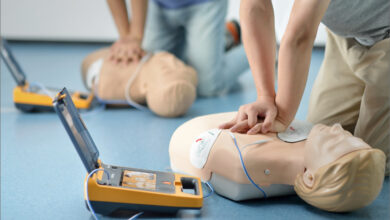Struggling with Whiplash? 5 Physiotherapy Techniques for Relief

Whiplash is one of the most common neck injuries. It often occurs after a sudden, forceful head movement strains the neck’s soft tissues. The pain and discomfort caused by whiplash make it difficult to perform everyday tasks. Motor vehicle accident physiotherapy in Edmonton is crucial in managing symptoms, restoring movement, and preventing long-term complications.
Understanding Whiplash: Causes and Symptoms
Whiplash occurs when a sudden acceleration-deceleration motion forces the neck beyond its normal range, commonly resulting from car accidents, sports injuries, and slips or falls. Rear-end collisions, high-impact sports like football or hockey, and sudden jolts from falls can strain the neck, leading to symptoms that may appear immediately or within 24-48 hours.
Common signs include neck pain and stiffness, limited range of motion, headaches, shoulder and upper back pain, dizziness, numbness in the arms, and cognitive difficulties like fatigue or trouble concentrating—left untreated, whiplash results in chronic pain and mobility issues. Motor vehicle accident physiotherapy in Edmonton is essential in recovery, helping to relieve pain, restore movement, and strengthen affected muscles for long-term relief.
Five Physiotherapy Techniques for Whiplash Relief
1. Cervical Mobilization
Cervical mobilization is a hands-on therapy technique that aims to improve the movement of the cervical spine (neck). After a whiplash injury, the neck joints can become stiff and restricted due to inflammation, muscle guarding, and pain. Cervical mobilization involves gentle, controlled movements the physiotherapist performs to target the specific joints in the neck. These movements are designed to reduce joint stiffness and alleviate discomfort by enhancing the mobility of the cervical spine.
The physiotherapist will apply low-force, oscillatory movements within the patient’s pain tolerance, helping to ease muscle tension, promote blood circulation, and facilitate healing. It is beneficial for patients with reduced neck mobility, helping to restore functional neck movement and reduce the risk of long-term complications like chronic stiffness and pain.
2. Muscle Energy Techniques (MET)
Muscle Energy Techniques (MET) are manual therapy techniques where the physiotherapist instructs the patient to perform controlled contractions of specific muscles while the therapist provides gentle resistance. MET helps target the deep neck flexors, muscles, and fascia around the cervical spine for whiplash recovery. Whiplash often causes muscle spasms, tension, and stiffness in the neck and upper back, makes challenging to regain normal muscle function.
Using MET, the physiotherapist helps release tightness and muscle restrictions in the neck and shoulder region. The process involves having the patient push against the therapist’s resistance in a controlled manner, which helps to improve flexibility, restore muscle balance, and promote better mobility in the cervical spine. This technique is particularly beneficial in preventing muscle imbalances, improving range of motion, and managing pain associated with whiplash injuries.
3. Therapeutic Exercises for Strengthening and Flexibility
Restoring neck strength and flexibility is essential for recovering from whiplash and preventing long-term complications such as chronic stiffness and recurring pain. Physiotherapists design a gradual, structured exercise program tailored to the patient’s level of discomfort.
Neck stretching exercises help loosen tight muscles and improve mobility—patients are guided through gentle side bends, forward and backward tilts, and controlled rotations within a pain-free range.
Strengthening exercises, like chin tucks, activate the deep neck flexors, supporting the spine’s stability. Shoulder blade squeezes help counteract muscle imbalances by strengthening the upper back and improving posture. Isometric exercises, where the patient presses their head against their palm in different directions without actual movement, help restore muscle strength without excessive strain.
Performing these exercises enhances neck function, reduces pain, and consistently prevents long-term weakness associated with whiplash.
4. Postural Training and Ergonomics
After a whiplash injury, poor posture can further strain the already compromised neck muscles, leading to prolonged discomfort and limited mobility. Postural training in physiotherapy focuses on correcting spinal alignment and reducing unnecessary stress on the neck.
The session begins with assessing how the patient sits, stands, and moves throughout the day. The physiotherapist then introduces postural correction techniques, such as chin tucks, where the patient gently pulls the chin inward to align the head with the spine, strengthening the deep neck stabilizers.
Shoulder blade retraction exercises are also incorporated to counteract the tendency of the shoulders to roll forward, a standard post-whiplash compensation. Ergonomic modifications like supportive pillows help keep the neck neutral while sleeping.
By reinforcing correct posture, patients can significantly reduce muscle strain, prevent further injury, and promote faster healing.
5. Stress Reduction Technique
Progressive Muscle Relaxation (PMR) is one of the effective stress reduction techniques for whiplash recovery. This technique involves systematically relaxing different muscle groups in the body.
For patients with whiplash, PMR can be beneficial in targeting areas of muscle tension, such as the neck, shoulders, and upper back, commonly affected by the injury. By tensing the muscles for a few seconds and then releasing the tension, patients can experience a deep sense of relaxation, which reduces overall muscle stiffness and discomfort.
This technique not only helps to alleviate physical tension but also promotes mental relaxation, which helps to reduce the stress and anxiety that often accompany chronic pain. Regular practice of PMR can lower pain perception, increase blood circulation to the affected areas, and encourage a sense of control over the healing process.
As part of a comprehensive rehabilitation plan, PMR can contribute to a faster recovery from whiplash by easing muscle tightness, improving flexibility, and enhancing emotional well-being.
Recover Faster from Whiplash with Professional Physiotherapy Care
Whiplash is a debilitating condition, but with the proper physiotherapy techniques, relief and recovery are possible through motor vehicle accident physiotherapy in Edmonton. Seeking early physiotherapy intervention ensures a faster recovery and reduces the risk of chronic symptoms. Turning Point Physiotherapy in Edmonton treats whiplash injuries with personalized care and provides physiotherapy techniques. Professional guidance can make all the difference. Schedule an appointment today and take the first step toward long-term relief and recovery.
Keywords:
whiplash, physiotherapy, recovery, neck pain, stiffness, mobility, exercises, posture, treatment, injury, muscles, flexibility, healing, strength, motor vehicle accident physiotherapy Edmonton, Turning Point Physiotherapy Edmonton




